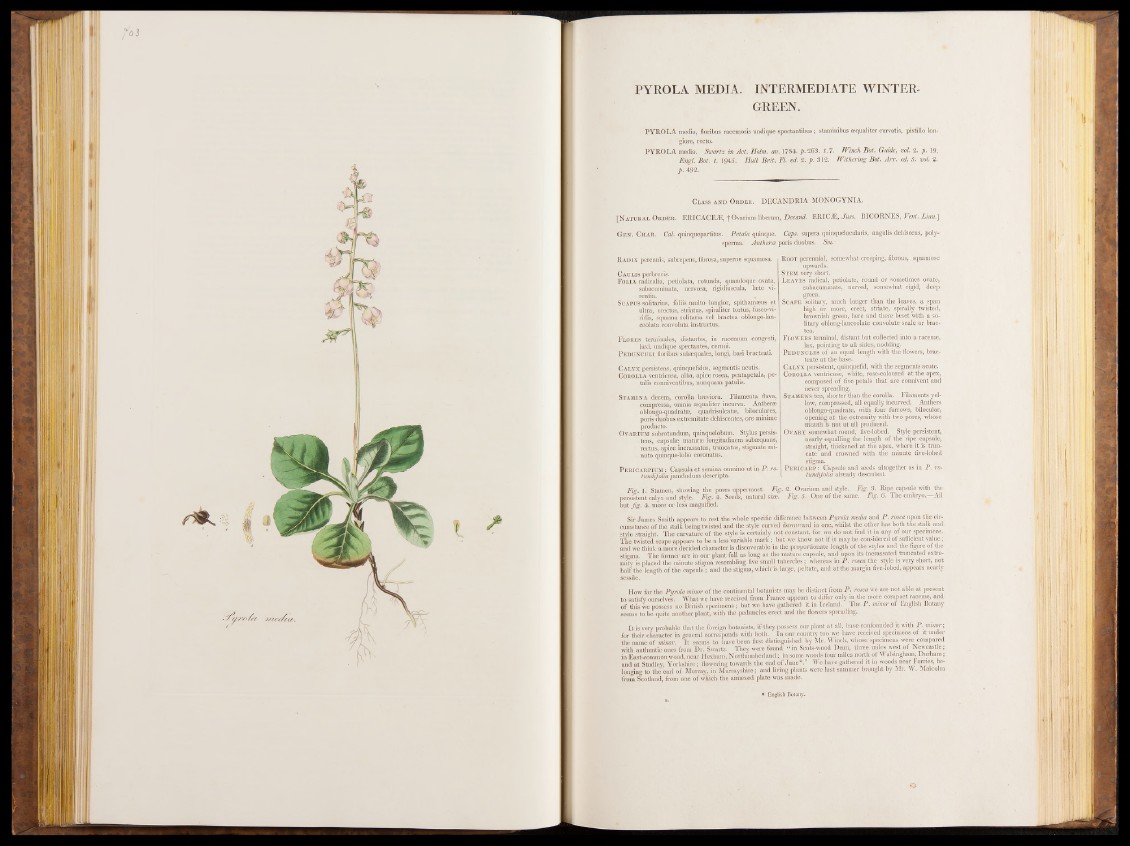
PYROLA MEDIA. INTERMEDIATE WINTERGREEN.
PYROLA media, floribus racemosis undique spectantibus; staminibus asqualiter curvatis, pistillo Ion-
* giore, recto.
PYROLA media. Swartz in Act. Holm. an. 1784. p. 263. t. 7. Winch Bot. Guide, ml. 2. p. 19.
Engl. Bot. t. 1945. H ull B r it. FI. ed. 2. p. 312. Withering B ot. A r r . ed. 5. ml. 2.
p. 492.
Class a n d Ord e r . DECANDRIA MONOGYNIA.
[N atural Ord e r . ERICACEiE, "[Ovarium liberum, Decand. E R ICM, Juss. BICORNES, Vmt. Linni]
Ge n . Ch a r . Cal. quinquepartitus. Petala quinque. Caps, supera quinquelocularis, angulis dehiscens, poly-
sperma. Antherce poris duohus. Sm.-
Root perennial, somewhat creeping, fibrous, squamose
upwards.
Stem very short.
Leaves radical, petiolate, round or sometimes ovate,
subacuminate, nerved, somewhat rigid, deep
Rad ix perennis, subrepens, fibrosa, superne squamosa.
Caulis perbrevis.
Folia radicalia, petiolata, rotunda, quandoqùe ovata,
subacuminata, nervosa, rigidiuscula, leete vi-
rentia. .
Scapus solitarius, foliis multo longior, spithamæus et
ultra, erectus, striatus, spiraliter tortus, fusco-vi-
. ridis, squama solitaria vel bractea oblongo-lan-
çeolata convoluta instructus.
F lores terminales, distantes, in racemum congesti,
laxi, undique spectantes, cernui.
P eduncul i floribus subæquales, longi, basi bracteati.
Calyx persistens, quinquefidus, segmentis acutis.
Corolla ventricosa, alba, apice rosea, pentapetala, pe-
talis conniventibus, nunquam patulis.
Stamin a decern, corolla breviora. Filamenta flava,
compressa, omnia oequaliter incurva. Antheræ
oblongo-quadratæ, quadrisulcatæ, biloculares,
poris auobus extremitate déhiscentes, ore minime
producto.
Ovarium subrotundum, quinquelobum. Stylus persistens,
capsulas maturæ longitudinem subæquans,
rectus, apice incrassatus, truncatus, stigmate minuta
quinque-lobo coronatus.
s P . ro-
Scape solitary, much longer than the leaves, a span
high or more, erect, striate, spirally twisted,
brownish green, here and there beset with a solitary
oblong-lanceolate convolute scale or bractea.
F lowers terminal, distant but collected into a raceme,
lax, pointing to all sides, nodding.
P eduncles of an equal length with the flowers, brac-
teate at the base.
Calyx persistent, quinquefid, with the segments acute.
Corolla ventricose, white, rose-coloured a t the apex,
composed of five petals that are connivent and
never spreading.
Stamens ten, shorter than the corolla. Filaments yellow,,
compressed, all equally incurved. Anthers
oblongo-quadrate, with four furrows, bilocular,
opening at the extremity with two pores, whose
mouth is not a t all produced.
Ovary somewhat round, five-lobed. Style persistent,
nearly equalling the length of the ripe capsule,
straight, thickened a t the apex, where it is truncate
and crowned with the minute five-lobed
stigma.
P erica r p : Capsule and seeds altogether as in P . ro-
tundifolia already described.
PERICARPIUM: Capsula et semina omnino ut i
tundifolia jamdudum descripta.
Fig. ].' Stamen, showing the pores uppermost. Fig. 2. Ovarium and style. Fig. 3. Ripe capsule with the
persistent calyx and style. Fig. 4. Seeds, natural size. Fig. 5. One of the same. Fig. 6. The embryo.—All
but Jig. 4. more or less magnified.
Sir James Smith appears to rest the whole specific difference between Pyrola media and P . rosea upon the circumstance
of the stalk being twisted and the style curved downward in one, whilst the other has both the stalk and
style straight. The curvature of the style is certainly not constant, for we do not find it in any of our specimens,
The twisted scape appears to be a less variable mark; but we know not if it may be considered of sufficient value;
and we think a more decided character is discoverable in the proportionate length of the styles and the figure of the
stiama. The former are in our plant full as long as the mature capsule, and upon its incrassated truncated extremity
is placed the minute stigma resembling five small tubercles; whereas in P . rosea the style is very short, not
half the length of the capsule; and the stigma, which'is large, peltate, and at the margin five-lobed, appears nearly
sessile. -
How far the Pyrola minor of the continental botanists may be distinct from P . rosea we are not able at present
to satisfy ourselves. What we have received from France appears to differ only in the more compact raceme, and
of this we possess no British specimens; but we have gathered it in Iceland. The P . minor of English Botany
seems to be quite another plant, with the peduncles erect and the flowers spreading.
I t is very probable that the foreign botanists, i f they possess our plant at all, have confounded it with P . minor;
for their character in general corresponds with both. In our country too we have received specimens of it under
the name of minor. I t seems to have been first distinguished by Mr. Winch, whose specimens were compared
with authentic ones from Dr. Swartz. They were found “ in Scots-wood Dean, three miles west of Newcastle ;
in East-common wood, near Hexham, N orthumberland; in some woods four miles north of Walsingham, Durham;
and at Studley, Yorkshire; flowering towards the end of June*.” We have gathered it in woods near Forries, belonging
to the” earl of Murray, in Murrayshire; and living plants were last summer brought by Mr. W. Malcolm
from Scotland, from one of which the annexed plate was made.
1 English Botany.